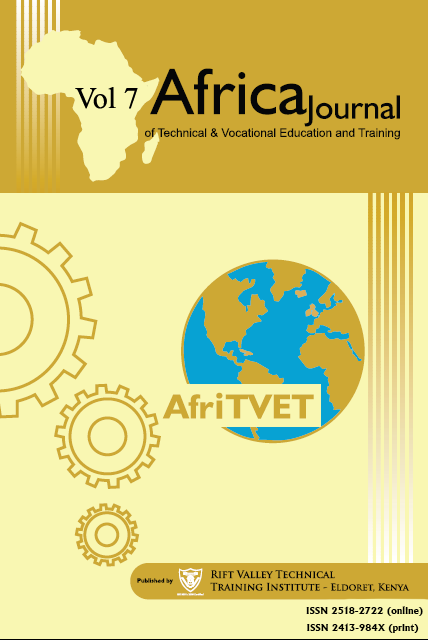Discussion of Test Results and Possible Domestic uses of Commercially Available Micro- Permanent Magnet 3-Phase Generator
Abstract
This paper discusses the technology and possible uses of a Micro–Permanent Magnet 3-phase alternator that is commercially available. These tiny rotating machines can deliver a few Watts of electric power and can be used to power small electronic appliances and devices in the home. These alternators or generators can be utilized particularly in rural areas where homesteads are typically off-grid or in urban areas where customers may suffer from lack of available power during load-shedding. The aim of this paper is to highlight the importance of permanent magnet AC generators. To this end a small commercially available machine was inspected and tested with the intention of reviewing the internal components and estimating some parameters like the Winding Factor and Air-gap Flux resulting in the appropriate generated voltage. The paper also investigates the generated voltage at different shaft speeds and loads. The open-circuit and full-load tests are also performed. The paper also looks at ways in which losses can be reduced and the output power can be optimized. It is noted that such generators are suited to relatively slow shaft speeds that could be provided by steady streams of water, wind-power and other direct-drive mechanisms like motors found around the home. These machines have simple construction consisting of rotating and fixed components made from relatively inexpensive metals and could be candidates for manufacture on the African continent using indigenous materials. Finally, a brief discussion is introduced related to the manufacture and production of such a machine and the possible demand constraints in the current economic climate.
Article Views and Downloands Counter
References
Bircraft. (2021). Geared motors, linear actuators, controls. https://bircraft.co.za/
Carrillo-Rosero, M., Carillo, M., Claudio-Medina, C., & Mayorga-Pardo, A. (2018).Characterization of an axial flow generator for application in wind energy. https://www.redalyc.org/journal/5055/505554803002/movil/
Chapman, S. J. (2012). Electric Machinery Fundamentals (5th Edition). McGraw-Hill 2012 International Edition, ISBN-13: 978-0071086172. ISBN-10: 007108617X.
Energy Use Calculator, (EUC). (2021). Electricity usage of a cellphone charger. https://energyusecalculator.com/electricity_cellphone.htm#:~:text=Cell%20Phones%20use%20approximately%202,dollar%20for%20a%20full%20year .
Jenkins Electric Motors, (JEM SA). (2021). Distributors and parts. https://www. jenkinselectricmotors.co.za.
Mantech, (2021). 3-Phase brushless permanent magnet motor generator alternator 10V - 4.5W – 3000 RPM. https://www.mantech.co.za/ProductInfo.aspx?Item=72M3650.
Nordelöf, A. & Tillman, A. (2017). A Scalable Life Cycle Inventory of an Electrical Automotive Traction Machine—Part II: Manufacturing Processes. The International Journal of Life Cycle Assessment volume 23, pages295–313 DOI 10.1007/s11367-017-1309-8.
Parsons, R. (2019). Selecting the best pole and slot combination for a BLDC (PMSM) motor with concentrated windings. Things in Motion. https://things-in-motion. blogspot.com/2019/01/.
Transvaal Electric Motors, (TVE). (2021). Manufacturers & repairers of TVE Motors. https://www.transelectric.co.za.
Valchev, V. C., Yankov, P. V. & Marinov, A. S. (2009). PMSM/BLDC as Generators in Renewable Energy Conversion Systems. Annual Journal of Electronics, ISSN 1313-1842.
WEG. (2021). Electric Motors. https:// https://www.weg.net/institutional/ZA/en/. Yang, X., Patterson, D., & Hudgins, J. (2015). Permanent magnet generator design and control for large wind turbines. Conference Paper, July 2012. DOI: 10.1109/PEMWA.2012.6316367
Copyright (c) 2022 Africa Journal of Technical and Vocational Education and Training

This work is licensed under a Creative Commons Attribution-NonCommercial-ShareAlike 4.0 International License.
Copyright Notice Copyright of published articles is held by AfriTVET. No limitation will be placed on the personal freedom of authors to copy or to use in subsequent work, material contained in their papers. Please contact the Publisher for clarification if you are unsure of the use of copyright material. Apart from fair dealing for the purposes of research and private study, or criticism and or review, this publication may only be reproduced, stored or transmitted, in any form or by any means, with the prior permission in writing of the Publishers.


